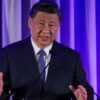Finance
U.S. tariff unsureness places China-made Christmas items in query
YIWU, CHINA – NOVEMBER 26: Overseas shoppers choose festive items at China Yiwu World Business Town on November 26, 2024 in Yiwu, Zhejiang Province of China.
Hu Xiao/VCG by the use of Getty Pictures
For years, Christmas products has been hitting the U.S. cabinets previous, as shops struggle to capitalize at the profitable sleep season — a retail phenomenon referred to as “Christmas creep.”
Alternatively, price lists may well be the Grinch that disrupts year-end festivities, as Chinese language factories and their U.S. consumers navigate tariff uncertainties to safeguard that cabinets stateside shall be well-stocked in year for Christmas.
In a while later U.S. President Donald Trump unveiled sweeping price lists on April 2 — together with a 34% tariff on imports from China that had been after ramped as much as 145% — many U.S. shops reacted through halting their orders from Chinese language providers, forcing factories to idleness manufacturing, consistent with CNBC interviews.
Alternatively, trade representatives say that some manufacturing has restarted within the terminating few days, as considerations about industry disruptions and neglected alternatives outweigh the tariff uncertainties.
“If you don’t start producing in the next couple of weeks, you’re going to start missing Black Friday and Christmas,” Cameron Johnson, Shanghai-based senior spouse at consulting company Tidalwave Answers, mentioned in a telephone interview Tuesday.
“Both sides are trying to be flexible to some degree,” he mentioned. “Retailers are starting to realize if these supply chains stop, it will be much more difficult to get them up and running [again].”
Johnson described how, for instance, a idleness in orders for a manufacturing facility making spoons would affect the corporate that rolls the metal, in addition to the iron ore smelter. “These supply chains themselves, the upstream, are also starting to close down. If they close down, even if we have some kind of a deal, it will take time for things to [restart].”
Regardless of some redirection of China-made items thru alternative nations, changing present provide chains and delivery schedules shall be tricky to reach in a single day. For 36% of U.S. imports from China, greater than 70% can best be sourced from mainland providers, consistent with a Goldman Sachs research previous in April.
For instance, digital merchandise want to be shipped out of China through early September to crash U.S. cabinets proper later the Thanksgiving sleep on the terminate of November, taking into consideration customs clearance and the distribution chain, mentioned Renaud Anjoran, CEO of Agilian Era, an electronics producer in China. The Guangdong-based corporate delivers part of its merchandise to the U.S. marketplace.
It takes round six months to assemble, check, form, and package deal, which means providers preferably must have began making ready for those orders in March, mentioned Anjoran.
Shrinking shipments
Many U.S. consumers had began stockpiling inventories since past due terminating yr, expecting upper price lists later Trump returned to place of business. As frontloading persevered, China’s exports to the U.S. rose through 9.1% in March from a yr in the past, consistent with CNBC’s calculation of reliable customs knowledge, pace imports from fell 9.5% on yr. April industry figures are anticipated to be excepted on Might 9.
However the ones frontloading efforts have began to dwindle. The choice of cargo-carrying container ships departing from China to the U.S. has fallen sharply in fresh weeks, consistent with Morgan Stanley’s monitoring of high-frequency delivery signs. Opposed shipments have additionally skyrocketed through 14 instances within the 4 weeks from April 14 to Might 5, in comparison to the length from March 10 to April 7, the funding reserve mentioned.
In April, a gauge of brandnew export orders from Chinese language factories fell to the bottom stage since past due 2022, consistent with the nationwide statistics bureau.
“Currently, we do not have a lot of purchase orders for the next few months from American customers,” Anjoran mentioned. Maximum of his shoppers have stockpiled stock that was once shipped to the U.S. ahead of Chinese language Fresh Life on the terminate of January, with some orders trickling in March and April.

Subscribe now
Some U.S. consumers are ready to peer whether or not price lists shall be decreased to a extra appropriate stage in Might ahead of resuming shipments, Ryan Zhao, a director at Jiangsu Inexperienced Willow Textile, instructed CNBC. For now, the corporate has manufacturing on store for orders from its U.S. shoppers.
Contemporary reviews pointed to a couple tariff reassurances at the field as each governments wished to blunt the commercial affects of punitive price lists. China reportedly granted tariff exemptions to positive U.S. items, together with pharmaceuticals, aerospace equipment, semiconductors, and ethane imports.
Within the original amusement, Trump signed an government form exempting overseas automobile and portions imports from spare levies, following an previous rollback of price lists on a field of digital merchandise, together with smartphones, computer systems and chips.
Seeking to year it proper
Regardless of considerations about benefit margins, some companies are hedging their bets through partly refilling orders from China in lieu than enduring the eye of unoccupied bundle cabinets, mentioned Tidalwave Answers’ Johnson.
“A few factories told me some U.S. importers have instructed them to resume production in an attempt to ‘time’ anticipated tariff relief,” Martin Crowley, vice chairman of product building at Seattle-based wholesale toy vendor Toysmith, mentioned in an e mail Tuesday. The corporate’s web page urges consumers to park orders through Might 16, for delivery through July 31, “to lock in current, non-tariffed pricing.”
Within the terminating few days, many factories within the production facilities of Yiwu, Shantou, and Dongguan have gained clearance from Walmart and Goal to renew manufacturing, Crowley added. Walmart and Goal didn’t right away reply to a CNBC request for remark.
Some Agilian consumers also are hanging rather smaller orders, making a bet that tariff charges will trim through the year their merchandise start at U.S. ports.
Alternatively, within the tournament of a leap forward in U.S.-China industry negotiations — and a hurry to backfill orders ensues — that might pressure up factories’ manufacturing prices and delivery costs.
“It is possible to rush, arrange production faster if quantities are not large … but if all American customers rush at the same time, the factories are going to be overwhelmed and air shipments will be quite expensive,” mentioned Anjoran.





